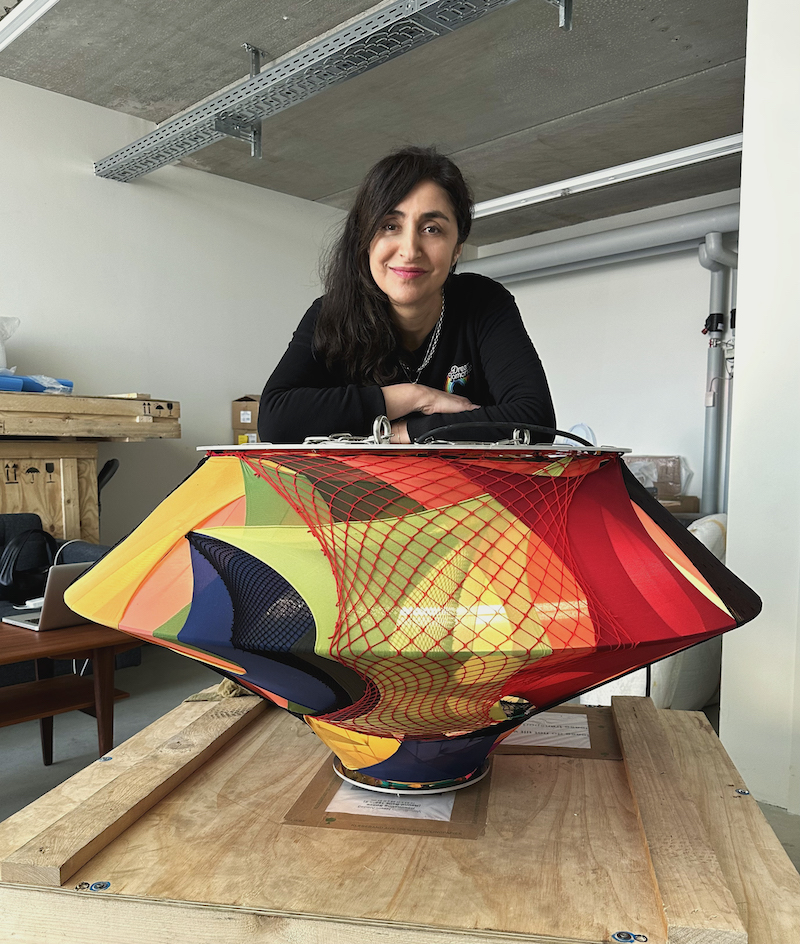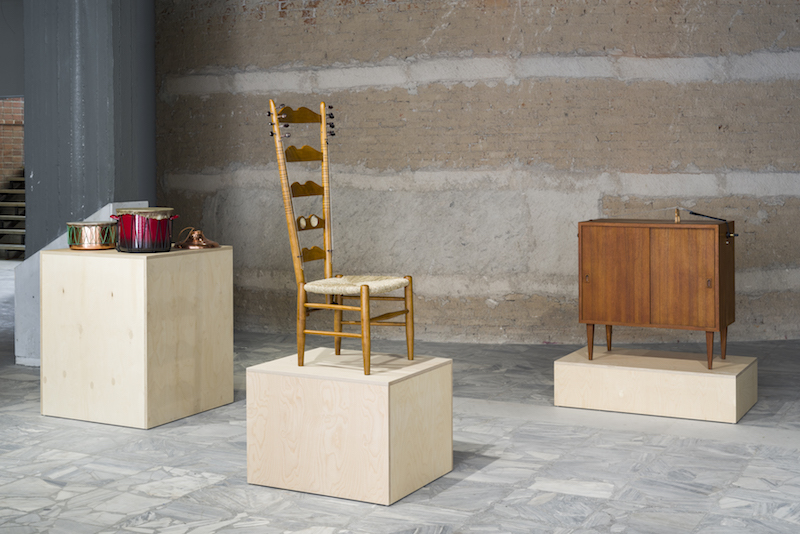by Noushin Afzali // June 4, 2024
Nevin Aladağ is well-known for her multi-media works—spanning sculpture, video, performance and sound—which blend diverse cultural narratives and artistic expressions, exploring themes of identity, community and the interplay between sound and space. Her distinctive approach often transforms everyday objects into vessels of cultural resonance and auditory experience, creating immersive environments that are marked by a deep engagement with the socio-cultural dimensions of sound and music.
In her practice, she frequently uses sound not merely as a medium but as a subject in itself. Her works often reflect on the ways in which music and rhythm can transcend cultural boundaries, fostering a sense of shared human experience. Whether through performances where everyday objects are played as instruments, or installations that translate the rhythms of urban life into visual forms, Aladağ’s art invites viewers to reconsider the connections between auditory and visual stimuli, and between individual and collective identities.
Her current exhibition, ‘Vibrating Images,’ at Wentrup Gallery in Berlin, exemplifies this approach. The exhibition features works that literally vibrate with sound and meaning. Aladağ reimagines musical instruments as sculptural forms and creates kinetic installations that produce harmonies through movement, transforming the gallery space into an immersive auditory landscape. ‘Vibrating Images’ also invites viewers to engage with art on a multi-sensory level, encouraging a deeper exploration of how we perceive and interact with the world around us. We spoke to Aladağ about the exhibition and her interest in bringing together sculpture and sound across her practice.

Nevin Aladağ, portrait // Photo by Daniela Kohl
Noushin Afzali: Your exploration of the boundaries between painting and sculpture challenges medium specificity. Can you talk about the significance of this blurring in your work?
Nevin Aladağ: Many of my works explore and blend seemingly defined structures and rules. The fluid transition of meanings opens up new discourse and interpretations. The boundaries between different mediums often feel arbitrary, as if imposed by external expectations rather than inherent qualities of the materials or forms themselves.
Painting is not my primary medium, but colors are. Colors carry emotional and symbolic weight, communicating in ways that words and shapes sometimes cannot. When boundaries blur, the viewer experiences art more holistically. They are not just seeing a sculpture or hearing a sound; they engage with a multisensory experience that defies easy categorization. This mirrors the fluidity of contemporary life, where identities and experiences are increasingly hybrid and interconnected.

Nevin Aladag: ‘Vibrating Images,’ 2024, installation view, Wentrup, Berlin // Courtesy of the artist and Wentrup, Berlin, photo by Matthias Kolb
NA: In ‘Vibrating Images,’ the incorporation of percussion instruments and sound holes in the wall objects adds a another dimension to the viewing experience. How do these elements transform the traditional notion of a static artwork into a dynamic and interactive piece that resonates with the audience?
NA: The percussive elements and string instruments in ‘Vibrating Images’ set the works in vibration, giving them their musical and personal character. These works are objects, but they are also played and activated by professional musicians to present their language to the audience. This transformation from static to dynamic is central to my exploration of art’s potential to engage on multiple levels.
Visitors are not just looking; they are listening, feeling, and anticipating sound and movement. The artworks become performers, interacting with the space and viewers. This interaction is both literal and metaphorical, creating an atmosphere that envelops the audience, making them part of the artwork.
Incorporating elements that require activation challenges passive consumption of art. The audience becomes co-creators of the experience, which varies with each interaction. This dynamic quality reflects the fluid, ever-changing nature of human perception and experience.

Nevin Aladag: ‘Vibrating Images, thundergong,’ 2024, acrylic paint on wood, gong, harp, thunder drums, pan flute, drums and bass guitar, 174 x 133 x 22 cm // Courtesy of the artist and Wentrup, Berlin, photo by Matthias Kolb
NA: Your earlier works involved modifying furniture pieces to function as musical instruments, creating a unique fusion of sculpture and sound. How has this exploration of sound, body and space in your previous installations influenced the development of ‘Vibrating Images’ as a visual and auditory experience?
NA: My earlier works, like the ‘Music Rooms’ and the ‘Resonator Sculptures,’ explored how everyday objects transformed into instruments could create new relationships between body, space and sound. Making furniture sing or resonate broke boundaries both literally and metaphorically.
The interweaving of carpets in the ‘Social Fabric’ series and the compositional arrangement of patterns in ‘Pattern Kinship’ influenced ‘Vibrating Images.’ These works showed me the musicality in visual forms and the visual potential in sounds.
‘Vibrating Images’ combines these different styles, creating sculptures that are visually dynamic and sonically vibrant. The experience of these pieces is both visual and auditory, encouraging viewers to consider how the two senses interact and influence each other. This development reflects a deepening of my interest in the interplay between sound, space and visual form, challenging traditional boundaries and encouraging a more integrated sensory experience.

Nevin Aladag: ‘Music Room Athens,’ 2017, installation view, documenta 14 // Photo by Trevor Good

Nevin Aladag: ‘Social Fabric,’ 2023, collage with carpets of various origins and materials on wood // Photo by Daniela Kohl
NA: Your projects often challenge traditional notions of identity by emphasizing the ephemeral nature of the acts you produce. How do you navigate the tension between the transient quality of your work and the common perception of identity as a stable and enduring condition?
NA: Everything is in a constant state of flux, and terms change meaning over time. My works are contemporary documents that may acquire new interpretations in the future. Identity, like art, is not fixed but constantly evolving.
My projects capture this transient quality, emphasizing that identity is not a singular, stable entity but a complex, fluid construct. This perspective allows exploration of themes like transformation, migration and cultural interplay. Ephemeral acts, like performances or interactive installations, highlight the temporality and multiplicity inherent in identity.
This approach challenges viewers to reconsider their perceptions of identity, suggesting it is shaped by experiences and interactions rather than static categories or labels. Art becomes a mirror reflecting the dynamic nature of identity.
Navigating this tension involves embracing uncertainty and change, seeing identity as a journey rather than a destination. My work invites viewers to find beauty and meaning in the ephemeral moments that shape who we are.
Exhibition Info
Wentrup Gallery
Nevin Aladağ: ‘Vibrating Images’
Exhibition: Apr. 26–June 22, 2024
wentrupgallery.com
Knesebeckstraße 95, 10623 Berlin, click here for map




















